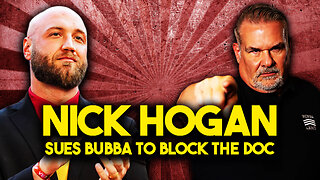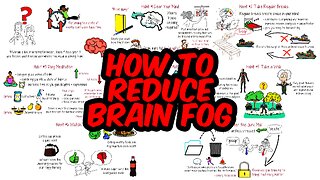Premium Only Content

President Trump’s New York Legal Problems Began in 1850.
Jonathan Turley brilliantly wrote:
In laying the foundation for his sweeping decision against former President Donald Trump, Judge Arthur Engoron observed that ‘this is a venial sin, not a mortal sin.’ Yet, at $355 million, one would think that Engoron had found Trump to be the source of Original Sin.
The actual sin in this debacle lies neither with President Trump, nor even Judge Engoron, but rather with David Dudley Field II, who after decades of lobbying succeeded in merging the New York courts of equity and law in 1850. What does that mean? And how did that woke word end up next to “law”?
Today the legal term “equity” usually appears only as a hint in the legal expression “equitable relief,” which refers to a set of very powerful orders that judges can access. Judge Engoron used “disgorgement” as equitable relief to justify his judgment. In 2020 the U.S. Supreme Court discussed “disgorgement,” and Justice Thomas wrote a lone dissent that reveals what is at stake:
According to our usual interpretive convention, ‘equitable relief’ refers to forms of equitable relief available in the English Court of Chancery at the time of the founding. Because disgorgement is a creation of the 20th century, it is not properly characterized as ‘equitable relief’…
More fundamentally, by failing to recognize that the problem is disgorgement itself, the majority undermines our entire system of equity. The majority believes that insistence on the traditional rules of equity is unnecessarily formalistic ... but the Founders accepted federal equitable powers only because those powers depended on traditional forms [emphasis added]. The Constitution was ratified on the understanding that equity was ‘a precise legal system’ with ‘specific equitable remed[ies].’
How did we get here? Please indulge me in a digression.
There are two general senses of “law.” All human societies have “criminal law,” transgressions of which provoke punishment. Healthy societies demand that criminal law apply universally and equally. There is also a sense that John Adams expressed well in Article XI of the Massachusetts’ Constitution: “Every subject of the commonwealth ought to find a certain remedy, by having recourse to the laws, for all injuries or wrongs which he may receive in his person, property, or character.” To find a remedy for every wrong requires the court to tailor rulings to individual circumstances and contrasts with universal application of criminal law. Every society has evolved methods to deal with the individual and universal aspects of their legal systems. In Anglo-Saxon tradition, these individual complaints gradually segregated into two different courts. Those whose remedies were fairly uniform became known as courts of common law; those demanding unique solutions were called courts of equity (or chancery). This is simplified, but it captures the gist.
Courts of law and equity developed different procedures and different judicial philosophies. Law courts focused on pleadings that sorted out what alleged facts mattered for the judgment; a jury tried any contested fact. The facts having been established, the judgment of the court was almost automatic, often concerning monetary damages. This uniformity in approach made any new type of judgment a precedent for future cases and, therefore, discouraged novel remedies. In order to craft a bespoke remedy, equity procedure gave the judge enormous power to determine facts; no jury was required. The court could subpoena documents and testimony and jail those non-compliant. Similarly, an equity judge could order a party to perform specific actions when necessary. In contrast to common law, equity judgments bound only the parties to the case and had little value as precedent.
This two-court system maximized individual freedom. Most squabbles would end up in a court of equity. Laws, whether from common law courts or statutes, could be kept to a minimum and remain universal in application. One big problem, however, was that every legal conflict has elements of equity and elements of law; one legal action could not give complete satisfaction to any litigant. To solve this problem, among others, Field proposed merging the two courts with one set of procedures (now called the Field Code). The judicial philosophies were to remain separate, and the judge could apply each to a case as needed. New York adopted the Field Code in 1850; other states followed as did the federal courts in 1938. The promise to maintain the two philosophies was gradually broken. The subpoena to produce documents, once limited to equity, was applied to all cases, which led to the abusive discovery practices that we take for granted today and to a huge advantage for the wealthy in lawsuits. Worse, it fostered confusion between the reasoning of law and equity, which brings us to President Trump’s case.
Judge Engoron’s decision quotes Executive Law § 63(12), which authorized the Attorney General to apply to a state court and to ask for “restitution and damages” for recurring fraudulent business practices. “[R]estitution and damages” both refer to compensating a victim, which this case famously lacks. Judge Engoron does mention a victim: “Timely and total repayment of loans does not extinguish the harm that false statements inflict on the marketplace.” However, this victim did not testify and was not offered monetary damages.
Judge Engoron supports his $355,000,000 judgment under the notion — rejected by Justice Thomas — of disgorgement by quoting from a New York Appeals Court decision:
[W]here, as here, there is a claim based on fraudulent activity, disgorgement may be available as an equitable remedy, notwithstanding the absence of loss to individuals or independent claims for restitution. Disgorgement is distinct from the remedy of restitution because it focuses on the gain to the wrongdoer as opposed to the loss to the victim. Thus, disgorgement aims to deter wrongdoing by preventing the wrongdoer from retaining ill-gotten gains from fraudulent conduct. Accordingly, the remedy of disgorgement does not require a showing or allegation of direct losses to consumers or the public; the source of the ill-gotten gains is ‘immaterial.’
This decision teems with the muddled thinking from mixing law and equity. The statute (law) enables the Attorney General (law enforcement) to use civil discovery (from equity) to investigate fraud (a potential crime) and bypass the Constitutional protections granted to someone accused of a crime (e.g, search warrants). Is that justice? Oh, it’s OK because restitution limits what can be extracted from the target. The AG is just getting compensation for victims, that’s all. “Restitution” is an equitable remedy, so there is no jury to try facts. Wait, the AG is a party in a civil suit, so don’t our rules of procedure allow access to all equitable remedies? This new-fangled “disgorgement” is floating around as an equitable remedy. They say it discourages wrongdoing by stripping the accused of their ill-gotten gains. Nothin’ wrong with that. Since disgorgement has no accepted legal meaning, what if we say that it doesn’t require identifiable victims because we’re discouraging wrongdoing. No victims, uh, who gets the money? Hey, we can put the money in the treasury! Neat, huh? Government employees in black robes gettin’ it done! Thank you, Mr. Field.
President Trump should not only make Justice Thomas’ dissent the basis of his appeal, he should also use it to quiz all his future SCOTUS candidates. https://www.americanthinker.com/articles/2024/02/president_trumps_new_york_legal_problems_began_in_1850.html
-
 4:58
4:58
JUST A HOMELESS MAN
11 months agoLefties losing it: Howard Stern’s ‘bile-filled rant’ about Donald Trump
3291 -
 2:00:57
2:00:57
BEK TV
1 day agoTrent Loos in the Morning - 9/03/2025
9.44K -
 LIVE
LIVE
The Bubba Army
23 hours agoNick Hogan Sues Bubba to BLOCK the DOC - Bubba the Love Sponge® Show | 9/03/25
1,766 watching -
 8:01
8:01
MattMorseTV
14 hours ago $11.87 earnedHe's ACTUALLY doing it...
82.5K84 -
 33:25
33:25
Uncommon Sense In Current Times
17 hours ago $3.66 earnedHollywood’s Woke Agenda Exposed | Kevin Sorbo on Cancel Culture, Faith & the Common Sense Revolution
32.5K3 -
 8:23
8:23
The Art of Improvement
22 hours ago $1.76 earned7 Smart Habits to Boost Mental Clarity
22.4K4 -
 12:09
12:09
China Uncensored
13 hours agoI Have NEVER Been More Furious
21.2K23 -
 2:12
2:12
WildCreatures
4 days ago $1.44 earnedThe beauty and mystery of the Pantanal, Brazil's best secret
15.7K3 -
 9:38
9:38
Millionaire Mentor
20 hours agoBernie Sanders LOSES IT After Scott Bessent’s Shocking Comeback
11.5K12 -
 1:35:35
1:35:35
Dialogue works
1 day ago $1.29 earnedLarry C. Johnson & Paul Craig Roberts: Trump’s Plan COLLAPSES as Russia Strikes — Xi & Modi Rise!
11K6